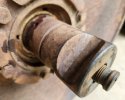Cub
Member
In February I bought a 1967 D6C Direct Drive Dozer serial # 74A2663. It started right up, had good oil pressure, No smoke to speak of, and sounded Good. The Chains, pads, and sprocket sections are like brand new. I should have lifted it up and checked out the bottom rolls. They're Junk. Both sides. No big deal as a complete set of NOS Rolls and 2 NOS Idlers were included in the sale. Like somebody started an undercarriage job but didn't for whatever reason finish it.
I did the Right side of the machine, to include Adjuster Seals. Easy Peasy. On to the Left side and the Track and Adjuster all came apart pretty easy. I find 6 Broken Bolts holding the Front Idler assembly together causing a Toe In situation resulting in uneven wear on the Idler itself. I Heated and Pounded, and Drilled, cussed some, and come to the conclusion, It ain't comin apart. The 4 Big Bolts holding the Idler Bearings came out fairly easy and it's lose and rolled ahead out of the way. The YOKE is the Issue. According to my Factory Service Manual, The Guys in the White Lab Coats removed the 2 Bolts on the end of The Recoil Rod, "Struck" it with a Hammer to separate it from the Yoke, slid the Rod out the Back and lifted the Yoke out to the Front. Yeah.... well that ain't happenin at my house. I beat on the Recoil Rod with a 12lb Sledge with limited swingin room, and it ain't comin apart. Probably never been apart since it was put together.
I got Mad... and Cut the Recoil Rod with a torch and got everything out on the ground. I know....Raised eyebrows and all. Here's the Delema. Parts book says I "Should Have" a Cat # 7M1844 Yoke. Stamped right into MY Yoke is #7M1775. Side Plates 7M1776. I'm thinkin best to put in the same new parts as the old ones that came out of it.
I have the correct Parts Book.
Service manual says that Recoil Rod will slide right in or out of that unit the Equalizer Bar and Forward Top Roll Mount to. Looks pretty tight to me.
Has anyone had experience with this procedure, or insight to these parts number discrepancies? The number 2P7984 has come up on my yoke search also.
Thanks in advance for any Wisdom sent my way.
I did the Right side of the machine, to include Adjuster Seals. Easy Peasy. On to the Left side and the Track and Adjuster all came apart pretty easy. I find 6 Broken Bolts holding the Front Idler assembly together causing a Toe In situation resulting in uneven wear on the Idler itself. I Heated and Pounded, and Drilled, cussed some, and come to the conclusion, It ain't comin apart. The 4 Big Bolts holding the Idler Bearings came out fairly easy and it's lose and rolled ahead out of the way. The YOKE is the Issue. According to my Factory Service Manual, The Guys in the White Lab Coats removed the 2 Bolts on the end of The Recoil Rod, "Struck" it with a Hammer to separate it from the Yoke, slid the Rod out the Back and lifted the Yoke out to the Front. Yeah.... well that ain't happenin at my house. I beat on the Recoil Rod with a 12lb Sledge with limited swingin room, and it ain't comin apart. Probably never been apart since it was put together.
I got Mad... and Cut the Recoil Rod with a torch and got everything out on the ground. I know....Raised eyebrows and all. Here's the Delema. Parts book says I "Should Have" a Cat # 7M1844 Yoke. Stamped right into MY Yoke is #7M1775. Side Plates 7M1776. I'm thinkin best to put in the same new parts as the old ones that came out of it.
I have the correct Parts Book.
Service manual says that Recoil Rod will slide right in or out of that unit the Equalizer Bar and Forward Top Roll Mount to. Looks pretty tight to me.
Has anyone had experience with this procedure, or insight to these parts number discrepancies? The number 2P7984 has come up on my yoke search also.
Thanks in advance for any Wisdom sent my way.

